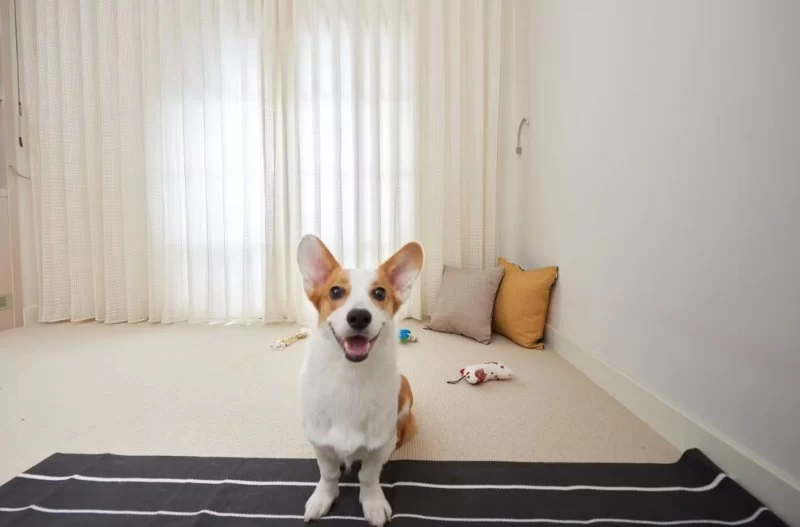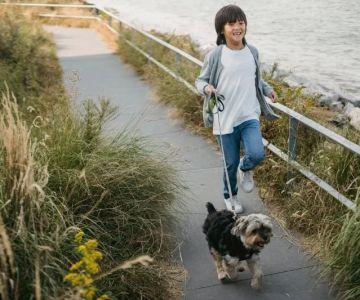1. Understanding Separation Anxiety in Dogs
Many dog owners know the heartbreak of coming home to chewed furniture, torn blinds, or anxious barking. These aren’t acts of disobedience—they’re signs of separation anxiety. Understanding why dogs develop this behavior is the first step in helping them overcome it. Dogs are social animals who rely on human companionship for comfort. When left alone, some dogs experience fear and panic, leading to destructive or self-soothing actions. This condition can affect any breed, age, or temperament, though it’s more common in rescued pets or those who’ve experienced sudden changes in their environment.
Veterinarians at Hidden Brook Veterinary explain that separation anxiety is not a sign of a “bad dog.” It’s a sign of distress. With proper training and patience, most dogs can learn to feel calm and safe when alone.
2. Recognizing the Signs of Separation Anxiety
2.1 Behavioral indicators
Common symptoms include excessive barking, whining, pacing, drooling, or scratching at doors and windows when left alone. Some dogs may urinate indoors despite being house-trained, or destroy objects near entryways. These actions are not out of defiance—they’re expressions of anxiety and fear.
2.2 Emotional and physical clues
You might also notice your dog becomes overly clingy before you leave or follows you from room to room. Physically, stress can manifest through trembling, panting, or loss of appetite. Recognizing these signs early helps prevent the condition from worsening.
2.3 Real-world example
One client at Hidden Brook Veterinary shared that her golden retriever, Milo, would bark nonstop whenever she left for work. Through patient training, Milo learned to stay calm when she departed, proving that even severe anxiety can improve with consistency and compassion.
3. The Root Causes Behind Dog Separation Anxiety
3.1 Early life experiences
Dogs who were separated too early from their mothers or who experienced unstable living conditions are more prone to anxiety. Shelter dogs, in particular, may associate solitude with abandonment.
3.2 Environmental changes
Major life shifts—like moving homes, a change in routine, or the loss of a family member—can trigger anxiety. Dogs thrive on predictability, and sudden change can make them feel insecure.
3.3 Overdependence on owners
While we love our dogs deeply, constant togetherness can make them overly reliant on us for comfort. Dogs who never spend time alone may find it overwhelming when suddenly left without their human companions.
4. Step-by-Step Training to Overcome Separation Anxiety
4.1 Step 1: Desensitization
Start small. Begin by leaving your dog alone for just a few minutes at a time. Gradually increase the duration as your dog becomes more comfortable. The goal is to teach your pet that you always return and that being alone isn’t scary. Avoid making a big fuss when you leave or come back—this helps normalize the process.
4.2 Step 2: Create positive associations
Before leaving, provide your dog with something enjoyable, like a favorite chew toy or a treat-dispensing puzzle. This shifts their focus from your departure to something fun. Over time, your dog will begin to associate alone time with rewards, not stress.
4.3 Step 3: Practice calm departures and arrivals
Resist the urge to give emotional goodbyes. A calm, confident exit communicates to your dog that there’s nothing to worry about. When you return, wait a few minutes before engaging. This reinforces that departures and arrivals are normal events.
4.4 Step 4: Provide mental and physical stimulation
Exercise plays a crucial role in managing anxiety. A tired dog is a calm dog. Daily walks, interactive toys, and short training sessions keep your dog’s mind and body active. Mental engagement reduces boredom—a major contributor to destructive behavior.
5. Building a Safe and Comfortable Environment
5.1 Create a “comfort zone”
Designate a cozy space for your dog with familiar scents, toys, and bedding. Some dogs feel more secure in a confined area, such as a crate with the door open. Soft background sounds like calming music or white noise can also reduce anxiety triggers from outside.
5.2 Maintain a consistent routine
Dogs find security in predictability. Try to feed, walk, and rest at the same times each day. Consistent structure helps them feel safe, even in your absence.
5.3 Try scent association
Leaving an unwashed T-shirt with your scent can help comfort your pet while you’re gone. Familiar smells provide reassurance and make your dog feel connected to you even when you’re away.
6. When Professional Help Is Needed
6.1 Consulting a veterinarian or trainer
If your dog’s anxiety is severe—manifesting in self-harm, escape attempts, or constant distress—seek professional guidance. Experts at Hidden Brook Veterinary can help identify underlying medical or behavioral causes and develop a customized training plan.
6.2 The role of behavioral therapy
Certified animal behaviorists can introduce desensitization and counterconditioning techniques tailored to your dog’s needs. In extreme cases, medication may be used temporarily to reduce anxiety and help your dog learn more effectively.
6.3 Real success stories
One family in California worked with a behavioral trainer after their rescue dog, Bella, tore through doors whenever left alone. After three months of gradual exposure and positive reinforcement, Bella now calmly lounges near the door when her owners leave. It’s a transformation that proves patience pays off.
7. Supporting Your Dog’s Emotional Health
7.1 The power of patience
Overcoming separation anxiety doesn’t happen overnight. It requires consistency, understanding, and time. Celebrate small victories—like your dog staying calm for a few extra minutes—and stay positive throughout the process.
7.2 Enrichment through social interaction
Dog daycare or trusted pet sitters can help dogs adjust to time away from their owners. Regular playdates or walks with other dogs can also build confidence and reduce dependency on one person.
7.3 Incorporating relaxation training
Teaching your dog relaxation cues, such as lying quietly on a mat, can help them self-soothe. Pairing these cues with gentle praise reinforces calm behavior and builds resilience.
8. Expert Advice from Hidden Brook Veterinary
8.1 Professional insights
At Hidden Brook Veterinary, specialists emphasize the importance of treating the root cause, not just the symptoms. They recommend combining physical activity, mental engagement, and emotional reassurance to address anxiety comprehensively.
8.2 Tools and support options
Modern pet care offers several tools—like pheromone diffusers, anxiety wraps, and calming supplements—that can complement behavioral training. These solutions, when guided by veterinary advice, can help dogs transition from anxious to confident.
8.3 A lifelong bond built on trust
Ultimately, training your dog to overcome separation anxiety strengthens your bond. It’s about teaching your furry friend that they’re safe, loved, and capable of being alone. With dedication and expert support, you can give your dog the calm, happy life they deserve.










